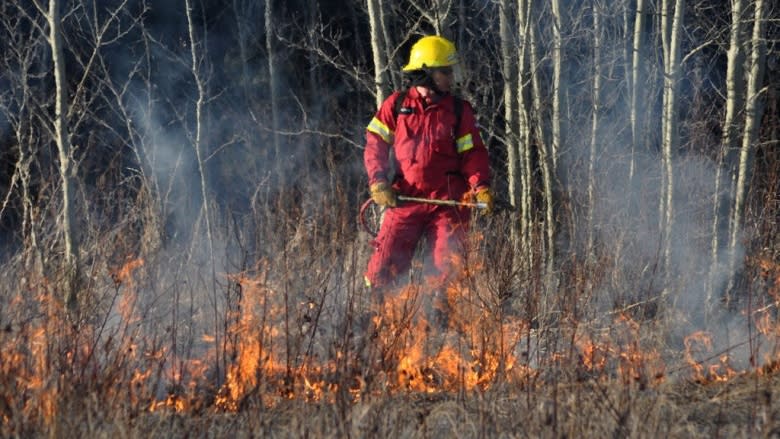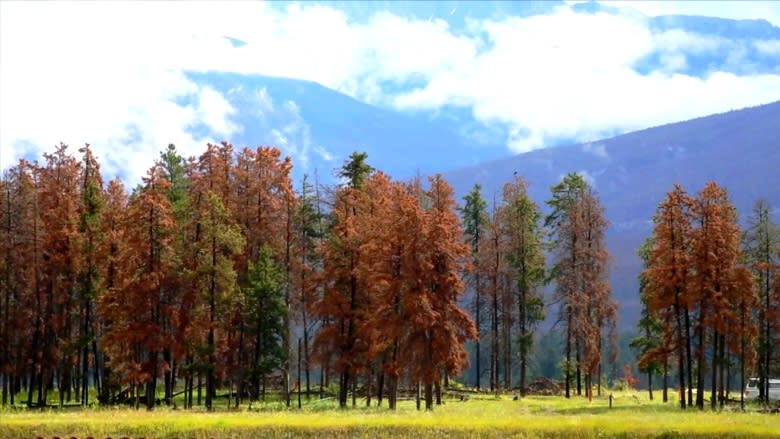As the 'red forest' encroaches, Jasper steps up measures to protect itself from wildfire
Already this month, Jasper has seen 10 times as much rain as it did in all of July 2017.
Yet fears about wildfires are growing in the mountain town, fuelled by the rusty, red colour of the surrounding forests — a visible reminder of the spreading pine beetle infestation and the area's increasing vulnerability to a blaze.
Jasper's residents, remembering the 2016 Fort McMurray fire and last summer's smoky haze through the Rocky Mountains from wildfires in B.C., are voicing concerns about the community's preparedness for a major fire.
"We have numerous pine beetle-attacked trees upwind of the community, which is raising concerns not just for residents, but visitors and other folks, as well," said Greg Van Tighem, fire chief for the Municipality of Jasper.
According to Environment Canada data, Jasper has received more than 75 millimetres of rain already this month, putting it on track to be the rainiest July since 2012. Last July was one of the driest, with about seven millimetres.
But it's not just weather that is drying up the forest.
The mountain pine beetle — which destroys pine trees, turning their needles a rusty reddish hue — has been encroaching on the trees in and and around Jasper for several years. The splashes of red are becoming more numerous, and getting closer to the townsite.
Hundreds pack community meeting
In May, hundreds of residents packed an open house on wildfire and emergency information, according to the local newspaper, The Jasper Fitzhugh. Demand was so strong the city is hosting a second information session this week.
Van Tighem says his message to residents is they must be personally prepared for the worst — namely an evacuation.
"They need to be prepared themselves, and they need to be prepared in the manner that if there's the potential for an evacuation, they need to be part of the solution, not the problem."
In a town with just a handful of gas stations, that means keeping your gas tank always near full and having a family evacuation plan in place.
Earlier this year, two researchers from B.C. criticized Parks Canada for how it is handling the fire risks in the forests near Jasper. Last year, Jasper Mayor Richard Ireland called the situation "worrisome" and he has said town council had been in extensive talks with Parks Canada about prevention measures.
Ireland could not be reached for comment this week.
David Argument, a resource conservation manager for Parks Canada, said that recent years have seen an acceleration of the fire prevention strategies the department has used in the fire-prone area of Jasper.
"Given the concern about the red forest, we're certainly taking steps to augment the work that's already in place," he said.
"I'd say there has been an acceleration, with the advent of the pine beetle, in some of that work. But the strategy is largely the same."
Argument said Jasper has been "FireSmarting" — referring to a nationwide wildfire program to help protect people, infrastructure and surrounding lands — for almost 15 years. Measures include thinning about 1,000 hectares of forests in and around the edges of town, essentially reducing the density of the standing trees. There are more plans to remove dead, dry tinder later this year.
"This winter, we'll remove about 500 hectares of standing, dead pine trees, using mechanical means," Argument said.
But a national park has unique concerns.
"We need to make sure we're doing it in a responsible manner," he said. "That we're doing it in the right place and protecting the other values we're concerned about here."
Argument said the federal department also offers the equipment and personnel to fight a wildfire if one starts, including a dedicated fire attack crew based in Jasper, a fire-dedicated helicopter and, when necessary, fire bans.



